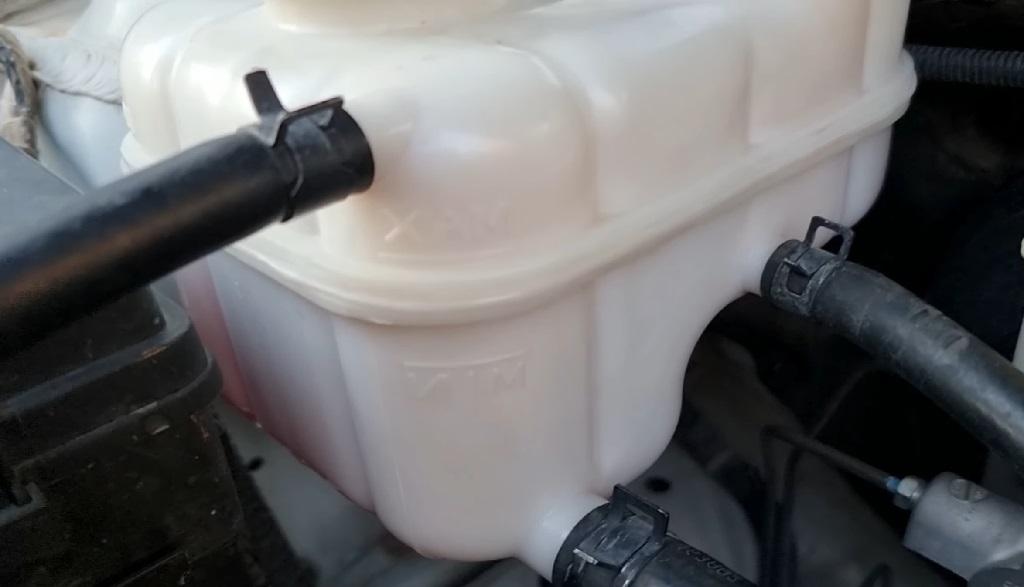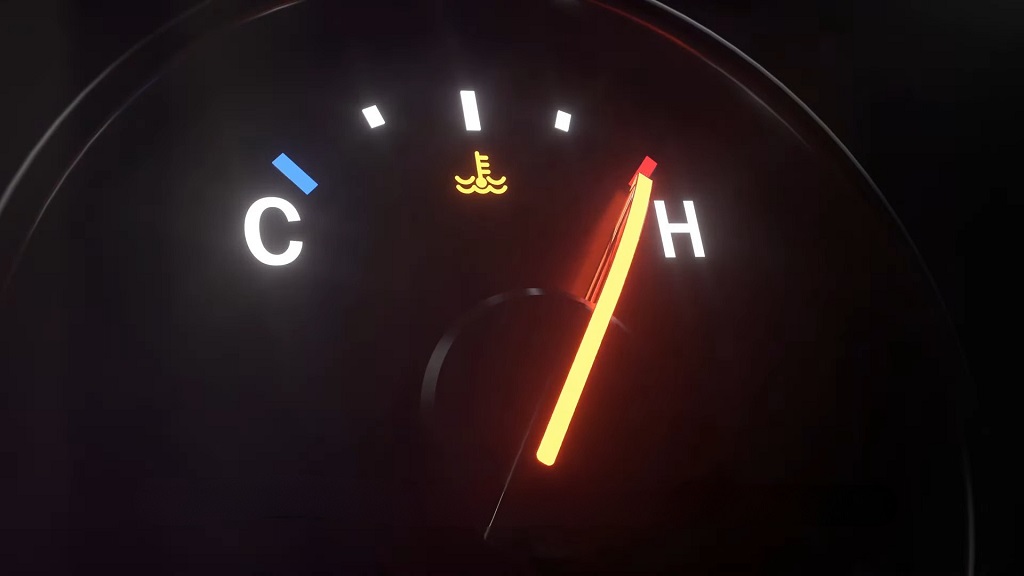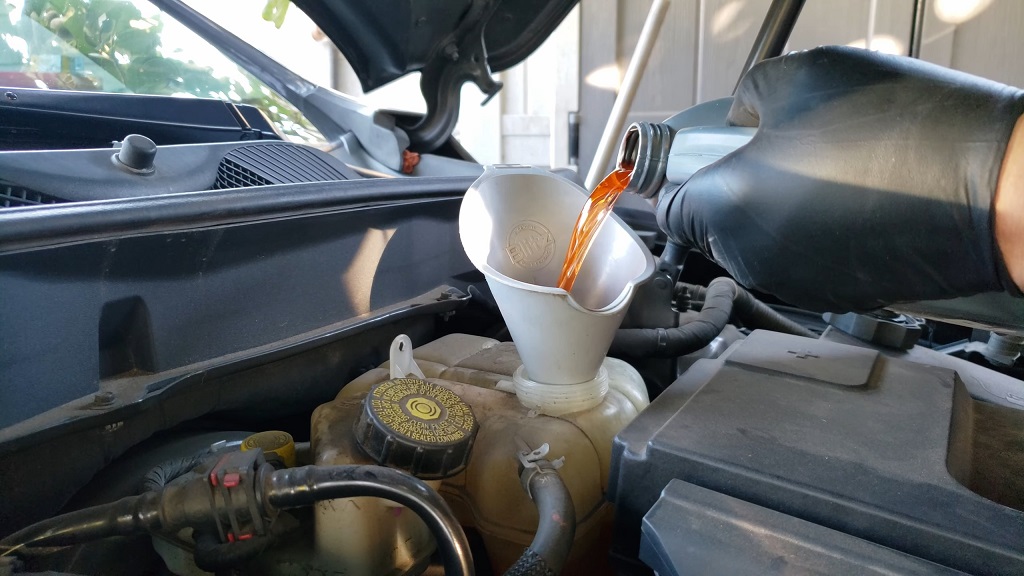You’re driving, the temperature gauge starts climbing, maybe steam begins to escape from under the hood, and then reality hits: your car’s coolant is low and you have none on hand. In that moment, many drivers wonder, “Can I just add water and keep going?”
The short answer is yes, but only in a very specific context. Automakers like Ford and Toyota actually say you can add water in a pinch to limp the car to a shop.
The long answer is more complicated, and knowing the details can mean the difference between saving your engine and wrecking it. If you’re stranded without coolant, you may add clean water to the reservoir or radiator, but only after the engine cools down. Then, drive gently and only far enough to reach a repair shop.
Automakers like Ford and Toyota publish this as an emergency measure, paired with warnings that water alone will damage the system if you continue using it.
Once you arrive at a shop, have the system inspected, leak-tested, and refilled with the proper coolant blend. To make things easier for you, we prepared a practical guide that explains when adding water is acceptable, what risks you take, how far you should push it, and what you must do afterward.
Along the way, we’ll break down the science behind coolant, show you the exact numbers that matter, and give you step-by-step instructions you can use if you’re ever stuck roadside.
Points to Remember
- Water can be used only as a short-term emergency substitute for coolant to reach a repair shop.
- Plain water lacks corrosion protection, lubrication, and freeze/boil resistance that coolant provides.
- Always let the engine cool fully before adding water, and use distilled water if possible.
- Once at a shop, the system must be flushed, leak-tested, and refilled with the correct coolant mix.
What Coolant Actually Does

Coolant is a carefully designed chemical cocktail of water, glycol (either ethylene or propylene), and additives that serve several critical roles:
- Raises the boiling point. Prevents the liquid from turning into steam under normal engine heat.
- Lowers the freezing point. Stops the fluid from expanding and cracking parts in winter.
- Corrosion inhibitors. Protect metals like aluminum radiators, heater cores, and water pump components.
- Lubricates seals. Keeps the water pump and hoses in good working condition.
- Controls foaming. Ensures stable circulation under pressure.
A recent Cars.com overview points out that water alone boils at 212°F and freezes at 32°F.
A 50/50 coolant mix, on the other hand, pushes those limits much farther and adds essential corrosion protection.
Boiling, Freezing, and Pressure
Cooling systems are pressurized, usually around 15-16 psi, which raises the boiling point of whatever is inside.
Each psi adds about 3°F before boiling. Here’s how it breaks down:
| Property | Plain Water | 50/50 Coolant Mix |
| Boiling point at 0 psi | 212°F (100°C) | ~220-223°F |
| Boiling point with 15 psi cap | ~250°F | ~265°F |
| Freezing point | 32°F (0°C) | ~−34°F (−37°C) |
| Corrosion protection | None | Yes |
| Pump seal lubrication | Minimal | Yes |
Why does this matter? Because if you’re running only water, your safety margin before boil-over shrinks. Add in corrosion risk, and you can see why automakers call it a “just until service” solution.
When Using Water Is Acceptable

- Roadside emergency only. If you’re stuck, the engine is cooled, and you need a short, low-load drive to the nearest shop.
- Manufacturer acknowledgment. Ford states you may add water in an emergency, while warning of potential damage if you keep running it. Toyota manuals echo the same guidance.
- No coolant available. If you can get coolant, always use that instead.
When Water Alone Is Not Acceptable
- Everyday operation. Running water long-term risks overheating, corrosion, and scale.
- Freezing weather. Plain water freezes at 32°F and can split radiators, hoses, or engine blocks. A proper 50/50 mix protects down to about −34°F.
- Heavy-duty engines. Diesels in particular can suffer from cavitation erosion without proper coolant chemistry.
Consumer automotive sources consistently emphasize that water-only operation is unsafe beyond the emergency trip to service.
The Safest Way to Top Off with Water in an Emergency
If you’re in the situation, here’s how to do it properly:
- Pull over immediately when the gauge climbs or you see steam. Turn off the A/C, turn the heater to hot, and shut the engine down.
- Wait at least 20-30 minutes. Never open a hot radiator cap. AAA and every service manual warn that scalding liquid is under pressure.
- Add water to the reservoir. If the reservoir is dry and you must use the radiator, open the cap only after cooling, with a cloth, and vent slowly.
- Restart and drive gently. Keep the heater on, go slow, and stop again if the gauge climbs.
- Head straight to a shop. Treat it like a lifeboat, not a new way of running your car.
What Kind of Water Should You Use?
- Best choice: distilled or demineralized. Hyundai and Nissan service documentation specifically instructs distilled water when mixing coolant, because it prevents scale.
- Second choice: bottled drinking water. Acceptable if clean and free of heavy minerals.
- Last choice: tap water. Use it only to get moving, then flush the system at the earliest chance.
The Correct Coolant-to-Water Mix in Normal Operation

For most cars, a 50/50 mix is the baseline. Ford’s guidance allows 40/60 for very hot regions and 60/40 for extreme cold, but outside of that window you compromise protection.
A few reminders:
- Never run 100% coolant. Pure glycol freezes around 0°F and transfers heat poorly.
- Pre-mixed coolant saves guesswork. If you buy full-strength, add distilled water to make the proper ratio.
- Check concentration with a refractometer or hydrometer if you’re unsure.
Why Water Alone Is Risky Even in Summer
Even if you never see freezing weather, water-only operation has serious risks:
- Lower boil margin. At altitude, water boils sooner, creating steam pockets around hot spots in the head.
- Corrosion. Without inhibitors, rust builds up in radiators, heater cores, and water pumps.
- Seal wear and foaming. Water doesn’t lubricate seals, and it allows air bubbles that interfere with circulation.
What to Do Once You Reach a Shop
The emergency isn’t over until you get professional service. The right steps are:
- Pressure test to find leaks.
- Flush to remove plain water and oxygen.
- Refill with the correct coolant chemistry for your vehicle.
- Check the radiator cap. A weak cap lowers system pressure, reducing your boil margin.
Toyota manuals emphasize that if you use water, have the system inspected as soon as possible.
Special Cases (Hybrids, EVs, and Fuel Cells)
- Hybrids/EVs. Many have multiple coolant loops for inverters and batteries. Toyota hybrid documents note you can use water in an emergency for the power control unit, but again, only until service.
- Fuel cell vehicles. Models like the Toyota Mirai specify never to add water to the stack cooling system. Always follow your manual for these advanced systems.
Frequently Asked Questions
Quick Decision Checklist
Keep this mental list, or screenshot it for emergencies:
- Is coolant truly unavailable?
- Engine completely cooled before opening?
- Add clean water to reservoir carefully.
- Heater on, drive gently, shortest distance possible.
- At shop: test, flush, refill with correct coolant.
- Check radiator cap health.
Bottom Line
You can use water instead of coolant only in an emergency, and only to limp to the nearest repair location. Automakers like Ford and Toyota make this clear.
Once you arrive, the system must be flushed and refilled with the proper coolant blend. Anything else invites overheating, corrosion, and costly repairs.
The physics explains why: water alone narrows your safety margin and provides zero protection for the metals inside your engine. It’s better than running dry, but it’s never a long-term solution.
